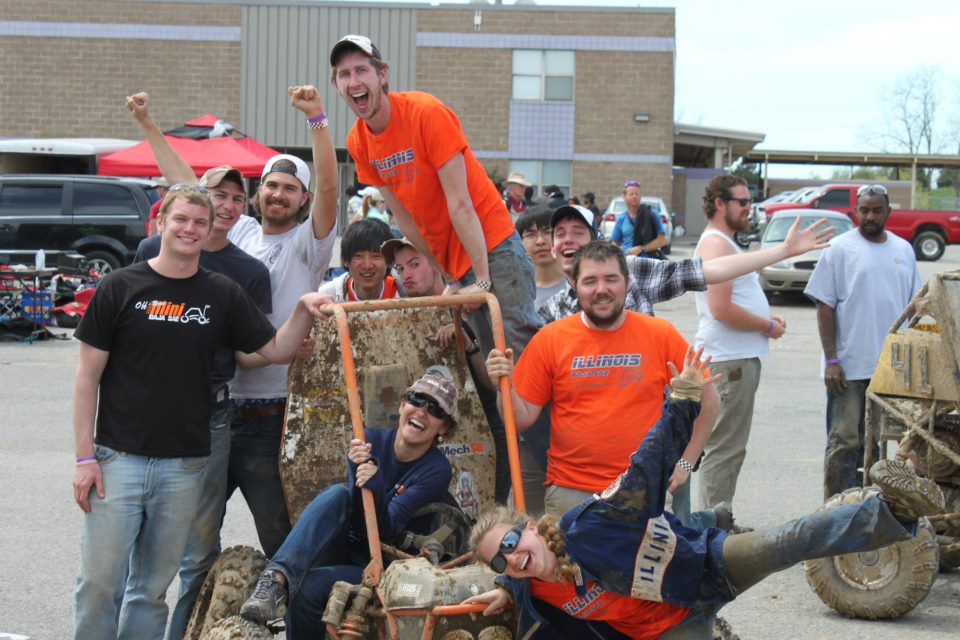Editor’s Note: This is Part 5 of our Campus Pit Stop series of articles highlighting automotive engineering work being done on campuses across America. The series covers some of the schools’ participation in the Formula SAE and Baja SAE programs. For more information on these programs, please see our Campus Pit Stop introduction post.
If you cut through all the engineering-speak and tech expertise, you really hone in on what the University of Illinois at Urbana-Champaign’s Baja SAE team members are trying to accomplish while building their off-road racing vehicle.
“This is meant to be a fun toy. A fun toy that goes fast,” said Jon Hutchings, the chassis captain for Off-Road Illini. “We design the car to have those kinds of characteristics.”
Like Formula SAE, these young engineers are building cars designed to play in the real world of passenger cars, off-road racing vehicles, and weekend-hobbyist powersports vehicles like utility quads and side by sides.
It’s a Marathon, Not a Sprint
The primary focus of Baja SAE teams is to build a robust, off-road vehicle.
In Formula SAE, the endurance component of each competition is about 20 minutes.
In Baja, the endurance competition lasts four hours. And not on smooth pavement. But through dirt and mud bogs and large berms and other obstacles.
And there is no replacing parts. If something breaks, you figure out how to patch it up and replace the part, make due without it, or just be done.
So, designing vehicles with quality in mind is of the utmost importance for teams like Off-Road Illini looking to better their rankings at next year’s Baja competitions.
“The key is building a car that isn’t necessarily the fastest, but can do the most laps in those four hours,” Hutchings said. “Speed is relevant. Cars that win are among the fastest. But the fastest car isn’t necessarily the one that’s going to win. It’s the one that’s in the pits the least.”
Last year—the 2013 Baja season—was the first of an entirely new platform, he said.
All Baja teams are required to run the same, unmodified engine—a 10-horsepower Briggs & Stratton Intek 20 single-cylinder with a 300cc displacement.
So, performance edges are gained primarily in chassis and suspension adjustments.
Suspension upgrades include a new independent rear suspension. This year, the team is adding H-arms similar to what you find on utility four-wheelers.
The team was able to shave about 100 pounds from 2012 to 2013, and Hutchings said the team hopes to continue the weight-shedding trend.
Weight loss and increasing efficiency are the focus.
The 2014 vehicle will have air shocks rather than the coil-spring dampers from last year. That change will make the car 12 pounds lighter, Hutchings said.
“We’re going to have a faster, more-agile car,” he said. “The limited-slip differential allows us to steer easier in tighter corners. And what can also help us is the ability to oversteer the car and let the back end slide out a little bit when cornering.”
All of these changes will contribute to the vehicle accelerating more quickly, braking more quickly, and taking off more precious pounds.
Taking Baja to the Real World
“We want to design a car that everyone on our team can drive,” Hutchings said. “We’re really sought after as engineers doing real-world applications. Competing in the real world using real-world tactics to solve problems.”
Hutchings has learned more about engineering vehicles through Baja than via any of his engineering classes, he said. He has a full-time job lined up after graduation as a chassis engineer at Chrysler in Auburn Hills, MI.
“A lot of the things I learned in Baja have really helped me in school work and professional work,” he said. “I learned new things about cars. How they work. How they’re built. And how not to build them.”
Safety Comes First
As part of those real-world engineering initiatives, Hutchings said the Baja team identifies safety as the absolute top priority, both in the context of driver safety and the criticalness of vehicle reliability.
“We have to design things for robustness,” he said. “Passenger cars. Powersports vehicles. Race cars.
“They have to be able to take the beatings. Cars are designed to last 200,000 miles-plus.
“Things like suspension members have to last as long as the car does. If they break, that’s a critical safety component.
“Safety is number one. We don’t want to make a car where we’re questioning whether it’s safe. That kind of mentality is really where we want to go in the industry.”
But, Still. Fun, Too.
“But also,” he said, “designing a fun vehicle.
“These Baja vehicles are so much fun to drive. They’re meant to be a fun toy.”
And in the end, that’s the ultimate litmus test, Hutchings said.
“If we’re having fun, we know we’re doing something right.”
Check out some videos of the UIUC Baja team doing its thing:


The development of own car by university students is unrealistically cool practice in the field of car engineering and mechanics. I advise mechanics and car builders to engage in such projects and not waste time writing papers that the service Paperial.com can write papers for money. Writing papers is not important for students who are involved in the study and practice of mechanics and engineering.
Really cool article